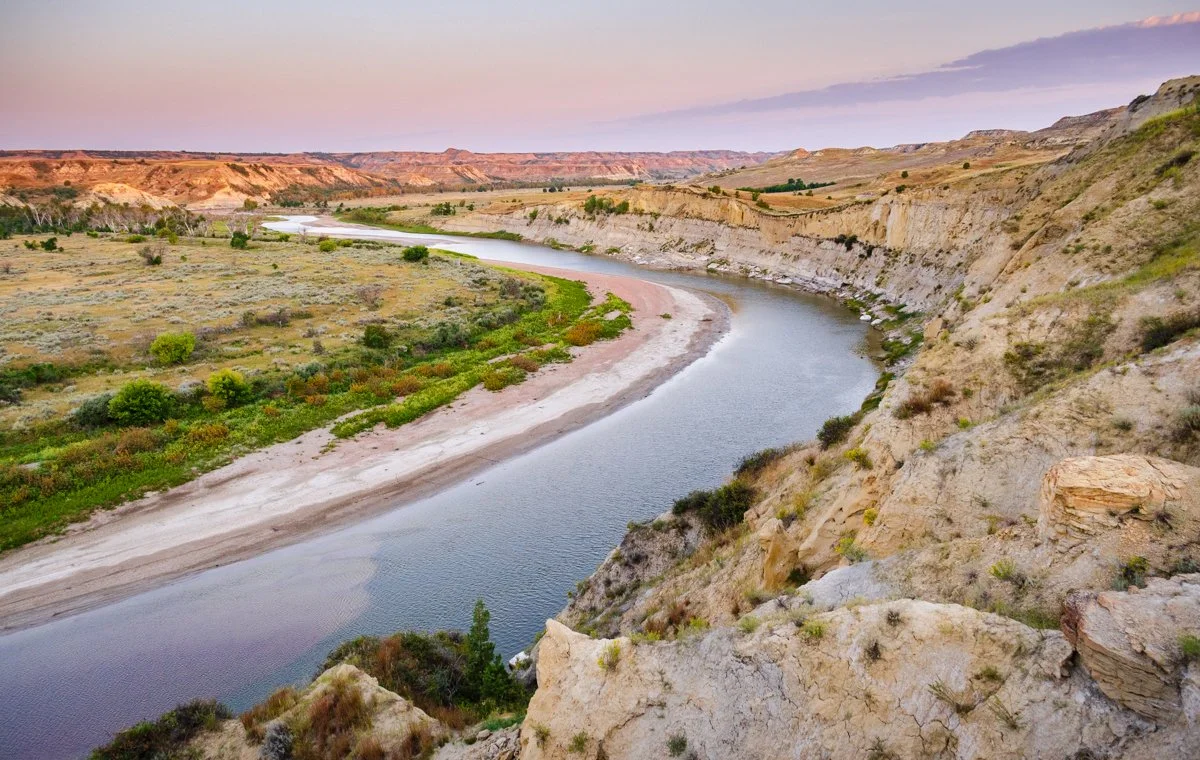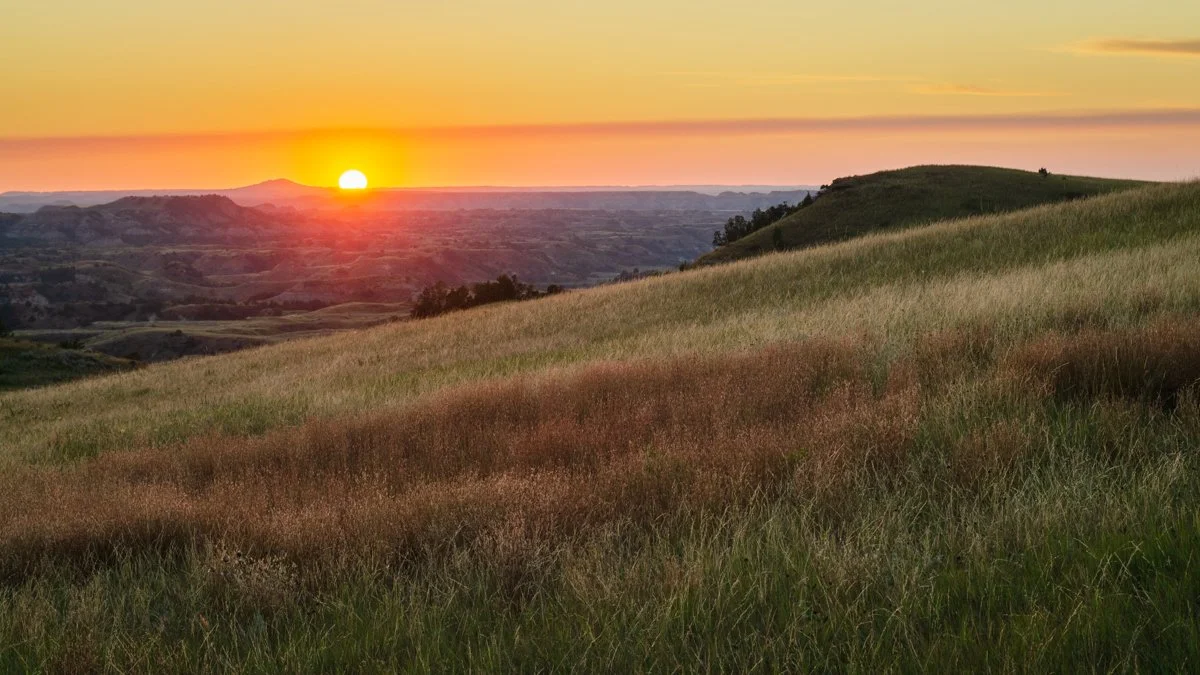Theodore Roosevelt National Park
(North Dakota)
Extending across the rugged badlands of western North Dakota, Theodore Roosevelt National Park is a testament to the indomitable spirit of the American West and the enduring legacy of the park's namesake, President Theodore Roosevelt. This extraordinary park, revered for its striking landscapes and abundant wildlife, invites visitors to step back in time and discover the untamed beauty of the North Dakota badlands.
Established as a national park in 1978, Theodore Roosevelt National Park spans over 70,000 acres and is divided into three distinct units: the North Unit, the South Unit, and the remote Elkhorn Ranch Unit. The park's breathtaking badlands, characterized by rugged terrain, colorful rock formations, and rolling grasslands, stand as a tribute to the region's geological history and Roosevelt's commitment to conservation.
Theodore Roosevelt National Park is home to an impressive variety of plant and animal life, which has adapted to thrive in the park's challenging environment. Iconic species such as bison, wild horses, and prairie dogs roam the park's diverse habitats, while the unique flora, including sagebrush, cottonwood trees, and juniper, adds to the park's distinctive allure.
Visitors to Theodore Roosevelt National Park can partake in a wide range of recreational activities that showcase the park's stunning beauty and rich history. The park offers over 100 miles of trails for hiking and horseback riding, allowing guests to explore the badlands, traverse grassy plateaus, or witness dramatic views from windswept overlooks. Other popular activities include wildlife viewing, stargazing, and learning about the park's connection to President Roosevelt through ranger-led programs and exhibits.
The nearby communities of Medora, Watford City, and Dickinson serve as gateways to Theodore Roosevelt National Park, offering a variety of accommodations, dining options, and local attractions. These vibrant towns ensure that every visitor can experience the park's untamed beauty and rich history in comfort and style.
MUST SEE SITES
Painted Canyon: This scenic area features stunning rock formations, opportunities for hiking and wildlife viewing, and a visitor center with exhibits and information on the area's geology and history. Visitors can explore the area by hiking one of the park's trails, attending a ranger-led program, or simply taking in the stunning views of the canyon and surrounding landscape.
Scenic Loop Drive: This scenic drive takes visitors through the heart of the park and offers opportunities for wildlife viewing, hiking, and stunning views of the surrounding badlands. Visitors can explore the area by taking a scenic drive, hiking one of the park's trails, or simply taking in the stunning views of the mountains and forests.
North Unit: This remote area of the park features rugged badlands, abundant wildlife, and opportunities for hiking and wildlife viewing. Visitors can explore the area by hiking one of the park's trails, attending a ranger-led program, or simply taking in the stunning views of the unique landscape.
Elkhorn Ranch: This historic site was once the home of President Theodore Roosevelt and offers exhibits and information on the area's rich cultural history, including the life of the president during his time in North Dakota. Visitors can explore the area by attending a ranger-led program, viewing the exhibits, or simply taking in the stunning views of the historic ranch.
Cannonball Concretions: This natural wonder located in the northern part of Theodore Roosevelt National Park offers visitors a chance to witness the beauty and uniqueness of the park's geological formations. The concretions are small, round rocks that have formed in the sedimentary rocks of the park and are a fascinating sight to behold. Visitors can hike along the trail that leads to the site and enjoy the stunning views of the surrounding wilderness.
GETTING THERE
The most popular way to arrive at Theodore Roosevelt National Park is by car. The park is located in western North Dakota, and can be accessed via several highways. From Bismarck, you can take Interstate 94 to the park's entrance.
If you prefer to travel by air, the closest airport to Theodore Roosevelt National Park is the Dickinson Theodore Roosevelt Regional Airport, which is located about an hour's drive from the park. This airport offers flights from several cities, including Denver and Minneapolis.
Once you arrive at Theodore Roosevelt National Park, the best way to get around is by car or by foot. The park is home to several scenic drives and hiking trails, including the 36-mile-long Scenic Loop Drive and the Wind Canyon Trail. There are also several campgrounds available for overnight stays, and ranger-led programs and tours are offered throughout the year.
GATEWAY COMMUNITIES
The towns of Medora, Watford City, and Dickinson serve as the primary gateway communities to Theodore Roosevelt National Park, offering various accommodations, dining options, souvenir shops, and outdoor recreation equipment rentals.
ACCOMMODATIONS
Visitors can find various lodging options in the surrounding communities, including hotels, motels, and vacation rentals. Additionally, there are several campgrounds available within the park, providing tent and RV sites.
CAMPGROUNDS
Theodore Roosevelt National Park has several developed campgrounds, offering tent and RV sites, as well as basic amenities like restrooms, drinking water, and picnic areas. Some campgrounds are available on a first-come, first-served basis, while others require reservations during the busy season, from May through September.
WEATHER/CLIMATE
Theodore Roosevelt National Park has a semi-arid climate, with hot summers and cold winters. Average summer temperatures can range from the 70s to 90s Fahrenheit, while winter temperatures can dip well below freezing. Visitors should be prepared for potential rain, snow, and rapidly changing weather conditions.
RECREATION OPPORTUNITIES
Numerous recreational opportunities await visitors, including hiking, wildlife viewing, and scenic drives. The park offers miles of hiking trails, providing opportunities to explore the diverse landscapes and observe the stunning badlands formations. Popular hikes include the Painted Canyon Trail, the Wind Canyon Trail, and the Caprock Coulee Trail. Wildlife viewing is popular, with a variety of species such as bison, elk, prairie dogs, and wild horses inhabiting the area.
VISITOR CENTER
Theodore Roosevelt National Park has several visitor centers, including the South Unit Visitor Center and the North Unit Visitor Center. These centers provide information about the park's history, ecology, wildlife, and recreational opportunities. Rangers are available to offer guidance and answer questions. The visitor centers are open daily during the visitor season, with reduced hours and services during the off-season.
THINGS TO KNOW
Entrance Fee: $30 per vehicle (7-day pass), $25 per motorcycle (7-day pass), $15 per person (7-day pass), or $55 for an annual park pass.
Pet Policy: Pets are allowed in developed areas, campgrounds, picnic areas, and along roads, but must be leashed and under control at all times. Pets are not allowed on hiking trails, in public buildings, or in the backcountry.
Hours of operation: Theodore Roosevelt National Park is open 24 hours a day, 7 days a week. Visitor centers and certain facilities have specific operating hours, which can be found on the park's website.
Website: https://www.nps.gov/thro/index.htm
Contact phone number: (701) 623-4466
Address: Theodore Roosevelt National Park, 315 2nd Avenue, Medora, ND 58645, United States




